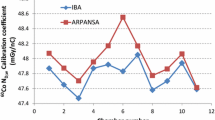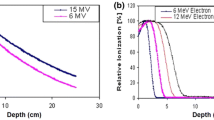Abstract
This work presents a comparison of air kerma rate (AKR) measurements performed by multiple radiotherapy centres for a single HDR 192Ir source. Two separate groups (consisting of 15 centres) performed AKR measurements at one of two host centres in Australia. Each group travelled to one of the host centres and measured the AKR of a single 192Ir source using their own equipment and local protocols. Results were compared to the 192Ir source calibration certificate provided by the manufacturer by means of a ratio of measured to certified AKR. The comparisons showed remarkably consistent results with the maximum deviation in measurement from the decay-corrected source certificate value being 1.1%. The maximum percentage difference between any two measurements was less than 2%. The comparisons demonstrated the consistency of well-chambers used for 192Ir AKR measurements in Australia, despite the lack of a local calibration service, and served as a valuable focal point for the exchange of ideas and dosimetry methods.



Similar content being viewed by others
References
Hoskin PJ, Rojas AM, Bownes PJ, Lowe GJ, Ostler PJ, Bryant L (2012) Randomised trial of external beam radiotherapy alone or combined with high-dose-rate brachytherapy boost for localised prostate cancer. Radiother Oncol 103(2):217–222
Australian Institute of Health & Welfare (2013) Prostate cancer in Australia. Australian Institute of Health and Welfare, Canberra, Australia
Australian Institute of Health & Welfare (2016) Australian Cancer Incidence and Mortality: cervical cancer. Institute of Health and Welfare, Canberra, Australia
Lee HJ, Kim YS, Shin SS, Nam J-H, Kim Y-T, Han S, Choi EK (2011) Long-term outcomes of concomitant chemoradiotherapy incorporating high-dose-rate brachytherapy to treat locally advanced cervical cancer. Tumori 98(5):615–621
Tan L, Coles C, Hart C, Tait E (2009) Clinical impact of computed tomography-based image-guided brachytherapy for cervix cancer using the tandem-ring applicator—the Addenbrooke’s experience. Clin Oncol 21(3):175–182
Haworth A, Wilfert L, Butler D et al (2013) Australasian brachytherapy audit: results of the ‘end-to-end’ dosimetry pilot study. J Med Imagin Radiat Oncol 57(4):490–498
Brown RL, Butler DJ (2010) The 2009 survey of therapy equipment and dosimetry practices in Australian radiotherapy centres. Australas Phys Eng Sci Med 33:229–285
Kirisits C, Federico M, Nkiwane K, Fidarova E, Jürgenliemk-Schulz I, de Leeuw A, Lindegaard J, Pötter R, Tanderup K (2015) Quality assurance in MR image guided adaptive brachytherapy for cervical cancer: final results of the EMBRACE study dummy run. Radiother Oncol 117(3):548–554
Dempsey C, Smith R, Nyathi T, Ceylan A, Howard L, Patel V, Das R, Haworth A (2013) ACPSEM brachytherapy working group recommendations for quality assurance in brachytherapy. Australas Phys Eng Sci Med 36(4):387
Thwaites D, Williams J, Aird E, Klevenhagen S, Williams PC (1992) A dosimetric intercomparison of megavoltage photon beams in UK radiotherapy centres. Phys Med Biol 37(2):445
Wachter-Gerstner N, Wachter S, Reinstadler E, Fellner C, Knocke TH, Wambersie A, Pötter R (2003) Bladder and rectum dose defined from MRI based treatment planning for cervix cancer brachytherapy: comparison of dose–volume histograms for organ contours and organ wall, comparison with ICRU rectum and bladder reference point. Radiother Oncol 68(3):269–276
Heeney C, McClean B, Kelly C (2005) A dosimetric intercomparison of brachytherapy facilities in Ireland, Scotland and the North of England. Radiother Oncol 74(2):149–156
De Almeida C, Pereira A, Marechal M, Pereira G, Cruz J, Ferraz J, Giordani A, Khalil C, Martins R, Menegussi G (1999) Intercomparison of calibration procedures for HDR sources in Brazil. Phys Med Biol 44(3):N31
Roué A, Venselaar JL, Ferreira IH, Bridier A, Van Dam J (2007) Development of a TLD mailed system for remote dosimetry audit for 192Ir HDR and PDR sources. Radiother Oncol 83(1):86–93
Haworth A, Wilfert L, Butler D, Ebert MA, Todd S, Bucci J, Duchesne GM, Joseph D, Kron T (2013) Australasian brachytherapy audit: results of the ‘end-to-end’dosimetry pilot study. J Med Imag Radiat Oncol 57(4):490–498
Shipley D, Sander T, Nutbrown R (2015) Source geometry factors for HDR 192Ir brachytherapy secondary standard well-type ionization chamber calibrations. Phys Med Biol 60(6):2573
Vandana S, Sharma S (2010) Long term response stability of a well-type ionization chamber used in calibration of high dose rate brachytherapy sources. J Med Phys 35(2):100
Mukwada G, Neveri G, Alkhatib Z, Waterhouse DK, Ebert M (2016) Commissioning of a well type chamber for HDR and LDR brachytherapy applications: a review of methodology and outcomes. Australas Phys Eng Sci Med 39(1):167–175
Andreo P, Cunningham J, Hohlfeld K, Svensson H (1987) Absorbed dose determination in photon and electron beams. An international Code of Practice.
Butler D, Haworth A, Sander T, Todd S (2008) Comparison of 192Ir air kerma calibration coefficients derived at ARPANSA using the interpolation method and at the National Physical Laboratory using a direct measurement. Australas Phys Eng Sci Med 31(4):332–338
Taylor BN, Kuyatt CE (1994) Guidelines for evaluating and expressing the uncertainty of NIST measurement results. US Department of Commerce, Technology Administration, National Institute of Standards and Technology, Gaithersburg, MD
Nath R, Anderson LL, Meli JA, Olch AJ, Stitt JA, Williamson JF (1997) Code of practice for brachytherapy physics: report of the AAPM Radiation Therapy Committee Task Group No. 56. Med Phys 24(10):1557–1598
IAEA (2002) TECDOC 1274. Calibration of photon and beta ray sources used in brachytherapy. Guidelines on standardized procedures at Secondary Standards Dosimetry Laboratories (SSDLs) and Hospitals. International Atomic Energy Agency, Vienna
Acknowledgements
The authors would like to acknowledge the following for their participation in the well-chamber intercomparisons: Ms. Soo Min Heng, Mr. Guilin Liu, Ms. Judith Martland, Mr. Andrew Howie, Mr. Virendra Patel, Mr. Paul Simpson, Ms. Emily Flower, Mr. Mounir Ibrahim, Mr. Mehran Goharian, Mr. Simon Atkins, Dr. Leon Dunn, Ms. Nikki Caswell, Ms. Rachitha Anthony, Dr. Vanessa Panettieri, Ms. Virginia Drumm and Ms. Hema Vaithaniathan.
Author information
Authors and Affiliations
Corresponding author
Ethics declarations
Conflict of interest
The authors declare that they have no conflicts of interest.
Ethical approval
This article does not contain any studies with human participants or animals performed by any of the authors.
Rights and permissions
About this article
Cite this article
Poder, J., Smith, R.L., Shelton, N. et al. High dose rate brachytherapy source measurement intercomparison. Australas Phys Eng Sci Med 40, 377–383 (2017). https://doi.org/10.1007/s13246-017-0542-6
Received:
Accepted:
Published:
Issue Date:
DOI: https://doi.org/10.1007/s13246-017-0542-6




